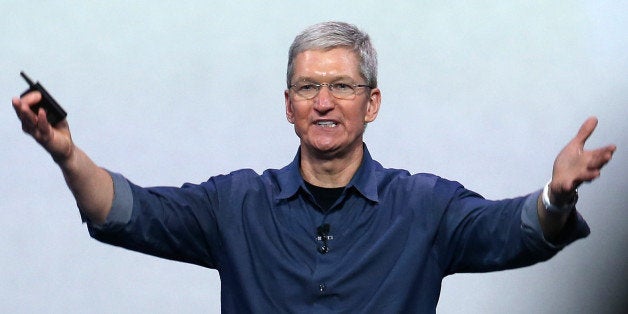
Do you already like your iPad and MacBook Air? Love your iPhone? If so, you have a whole lot to look forward to from Apple in 2015 -- a year when mobile will become advanced enough to fully replace the desktop experience, and when wearable technology like the mega-hyped Apple Watch will become mature enough to provide deeply beneficial use-cases to consumers. Even if you're not a zealot, Apple-watching is a spectacle with following: after all, the world's largest company and number one brand wields an astonishing amount of influence in every domain. Plus, you can be sure that every competitor is itching to see what to copy next.
Aside from the first public sale of the Watch, in the next 12 months one can be assured there will be updates to every major item on Apple's product line. That means new iPhones, new iPads, new iMacs and MacBooks, new software and new accessories. The fact that we'll have new iterations of products is nothing risky to forecast. As sure as the sun comes out in the morning, Apple will reveal new versions of its products once or more per annum. Now that they have the cash, the logistical operations and the engineering and creative prowess to reiterate regularly, Apple's greatest challenge is deciding what market to conquer next.
What is interesting about the forthcoming Apple lineup is that it will be as revolutionary as ever. Eight years after the iPhone was introduced in January 2007, Apple's yearly changes appear to be subtle to an unsuspecting consumer. And yet they are anything but.
Many of the most daunting challenges have been overcome in that span of time. For the great majority of everyday application, and for most devices, processor speed is no longer a major problem. Neither are storage, RAM capacity, or system architecture the impediments to a terrific user experience. Mobile computing manufacturers continue to shave millimeters off of their devices because they can: battery life improves with every new operating system, GPU upgrade and CPU-process shrink. As a result, apps today are miraculous: upon an average iPhone is a pantheon of programs boasting more utility (and probably less danger) than an old Sharper Image catalog.
That's why the real value to what we're likely to see over the next year will probably have upgrades more nuanced than bombastic in nature. The state of component hardware is now in position for revolutionary software and services to shine. Apple's best upcoming innovations will be a lot like Apple Pay: a disruptive idea that only works because Apple made it so, despite the fact that the vast majority of the technology was already in place (and arguably well-established) by competitors. For instance, Google Wallet existed on Android phones with NFC chips, and yet it wasn't until Apple Pay that the public really began using it. Now, you can't turn on your TV without seeing an advertisement for Apple Pay, and once you've used it you never want to go back to the old, insecure payment methods. Already, Apple Pay has doomed much of its competition.
We can read the tea leaves by checking out what Apple has already done and follow the clues to where they lead next. For instance, in the same way that Apple once instituted Touch ID only on the iPhone 5S, it's so popular and useful that it can now be found on every new iPad and iPhone. In that way, many of the small details found on one piece of Apple's hardware and software will be found elsewhere this year.
With these thoughts in mind, here are my top six predictions for Apple in the new year:
1) More free software. Apple will continue to develop new, beautiful and ever more useful versions of their consumer software and give it away "for free." Expect better versions of iTunes, iPhoto, iMovie, Pages, Numbers, Keynote and more -- on all devices (iOS and OS X). The major advancements this year? We'll see a tighter integration between devices due to reliance on an improving cloud -- one of the few things Apple has failed at in recent memory. We may also see Apple unveil first-party, cross-platform apps that take advantage of their newest hardware -- such as a full-fledged, elegant fitness and medical tracking application, similar to the Health app now found on iOS.
2) Better Beats. Apple spent billions of dollars acquiring a company that only had three assets worth mentioning: a line of high-margin headphones with a trendy brand, a streaming music service that very few subscribed to, and a team of impressive executives with sterling credentials. Apple will surely make great use of management like Dr. Dre and Jimmy Iovine -- after all, Tim Cook has demonstrated that he is more than willing to share the spotlight and responsibility with his lieutenants. What remains to be seen is what they will do with those two remaining assets. Beats have been long known as a style-first, sound-quality second type of product. We should expect that Apple's premier audio engineers will remedy that issue in short order -- meaning bad news for competitors like Bose.
It will be more difficult to bridge the gap on the streaming music side. For sure, the Beats music service and iTunes Radio will have to be married. No matter how forced and rushed, a merger must happen to compete with competitors like Spotify who have raised the bar. In the end, Apple has the assets (and the insider connections) to create a streaming service that consumers just can't wait to listen to. In the next year, we're likely to see the beginnings of such a combined service.
3) Retina everything. First the iPhone, then the MacBook Pro, then the iPad and now the iMac -- each has been a harbinger of prettier things to come. If you listen to the marketers, the human eye cannot resolve more than ~300 ppi from a distance of about a foot -- anything tighter, they say, is meaningless. Of course, for larger screens one sits farther away, so the pixel density can be lessened with the same perceived effect.
But even up close, Apple's new retina iMac is astonishing to behold. With a nearly "5K" resolution, the 27 inch screen is breathtaking; indeed, it is the highest resolution consumer display in the world. On the surface, that makes it an engineering marvel. The only issue is what's driving that sumptuous display: a last-generation GPU that provides adequate, but not extraordinary oomph. Prosumers (and professional video and image editors) should expect future iMacs with a lot more torque in the graphics department. In addition, the price on the innovative displays will come down, bringing the large-format retina technology a little more palatable to consumers with smaller wallets.
It's a lot easier to manufacture and drive ultra-resolution small displays, and consumers now require that experience on every device. After all, for some time now smartphones have had full 1080p screens, which only a few years ago was the domain only of desktop-class monitors and large HDTVs. Quickly, consumers grew accustomed to the idea that images on a display should look as good as those printed in a glossy publication. Although it was pricy, the MacBook Pro 15" went retina in 2012, and the 13" model found a retina model in 2013. Battery-life was the main reason why the uber-popular, super-slim MacBook Air couldn't make the leap this year. Fortunately, technology has improved and next year, a highly sought-after 12" model will roll out with a retina display. Experts say it will be thinner than any notebook Apple has ever created, including the razor-like Air, with a screen as bright and sharp as its much thicker (and older) brethren. Shortly thereafter, the whole MacBook and as a result, the entire mobile line will boast Retina.
4) Color everywhere. The new 12" laptop will have a luminescent screen... and a gorgeous exterior, to boot. Rumors have it that the new notebook will be available in the same set of colors currently found on the back of iPhones and iPads - space gray, silver, and an elegant gold. With new Apple executives like former Burberry CEO Angela Ahrendts and industrial designer Marc Newson aboard, don't be surprised if all the new MacBook Pros and Airs are swaddled in the same hues and tones of anodized aluminum -- and if iMacs get the same treatment down the road.
5) The best-yet iOS devices. The iPhone 6 and 6 Plus have giant, beautiful screens and they are as slim as can possibly be imagined. They come standard with NFC radios for Apple Pay, and have the best versions of all the technology integrated in the many iterations of iPhone that came before. But there's a lot left to improve, starting with the camera.
iPhone has had an 8 megapixel camera for several years. Although megapixel is not a very good metric for determining camera quality, the iPhone is due for a major upgrade in the camera department. And as the world's largest camera manufacturer, Apple has the pieces in place to make it happen. With the iPhone 6 and 6 Plus, consumers have accepted that their camera might protrude from the rest of the phone. That trend will continue with the iPhone 6S or iPhone 7, but the sacrifice in a flush grip will be worth the cost with a major upgrade: finally, images from a camera phone will approach those of an older but dedicated point-and-shoot.
Additionally, iPhone 6S will be shielded by a new type of glass -- most likely, one made of ultra-hard sapphire crystal. The production issues that prevented sapphire from encasing the iPhone 6 will abate in the coming months, and the new display will make scratches a thing of the past.
6) An Apple TV to get excited about. No one likes using a cable box. Ask anyone with a Tivo, a Chromecast, a Roku, Amazon Fire or a console: TVs are better used without resorting to junky, lowest-bidder hardware and software. Apple has long had their own offering in the space: the Apple TV, a tiny, rounded-corner black box that retails for $99 (and often sells for less than $80.).
Steve Jobs said he had the future of TV "cracked," but what we see today from Apple cannot be what he imagined. The Apple TV available now is a frankly pitiful device -- at least by Apple's lofty standards. It's lacking in hardware, but worse yet, it is deprived of an App Store, the lifeblood of every device ecosystem. As a result, it is impossible for a user to view content from sources like Amazon Prime, one of the very few genuine competitors to Netflix (which does have an app on the device). Moreover, with the exception of showing your own photos and files, logging onto the aforementioned Netflix, HBO Go, and a few sports-specific applications, the Apple TV has little practical value. Without the power of an App Store or the ability to connect cable to it directly, it's just a cheap box with zero storage and a slow chipset.
This year, things will change. A new Apple TV will emerge with local storage, with a new iOS-based operating system and an App Store that allows third-party developers to use their genius (and their labor) to build incredible solutions to TV problems we didn't know we had.
I leave you with my boldest prediction. Despite the fact that such a platform has not even been announced yet, by Christmas 2015, an Apple TV-native game will become part and parcel of popular culture. Imagine Angry Birds, but for the new Apple TV.
The Apple Watch may steal all the headlines over the next quarter, but just wait and see: Apple's other products like the Apple TV will make a bigger impact over the next 12 months. If I did not love mine so much, I might even bet my iPhone on it.
